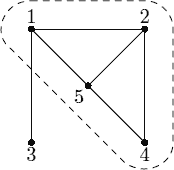poj 3155 Hard Life (最大密度子图)
2017-01-16 15:07
615 查看
Hard Life
John is a Chief Executive Officer at a privately owned medium size company. The owner of the company has decided to make his son Scott a manager in the company. John fears that the owner will ultimately give CEO position to Scott if he does well on his new manager position, so he decided to make Scott’s life as hard as possible by carefully selecting the team he is going to manage in the company. John knows which pairs of his people work poorly in the same team. John introduced a hardness factor of a team — it is a number of pairs of people from this team who work poorly in the same team divided by the total number of people in the team. The larger is the hardness factor, the harder is this team to manage. John wants to find a group of people in the company that are hardest to manage and make it Scott’s team. Please, help him.  In the example on the picture the hardest team consists of people 1, 2, 4, and 5. Among 4 of them 5 pairs work poorly in the same team, thus hardness factor is equal to 5⁄4. If we add person number 3 to the team then hardness factor decreases to 6⁄5. Input The first line of the input file contains two integer numbers n and m (1 ≤ n ≤ 100, 0 ≤ m ≤ 1000). Here n is a total number of people in the company (people are numbered from 1 to n), and m is the number of pairs of people who work poorly in the same team. Next m lines describe those pairs with two integer numbers ai and bi (1 ≤ ai, bi ≤ n, ai ≠ bi) on a line. The order of people in a pair is arbitrary and no pair is listed twice. Output Write to the output file an integer number k (1 ≤ k ≤ n) — the number of people in the hardest team, followed by k lines listing people from this team in ascending order. If there are multiple teams with the same hardness factor then write any one. Sample Input sample input #1 5 6 1 5 5 4 4 2 2 5 1 2 3 1 sample input #2 4 0 Sample Output sample output #1 4 1 2 4 5 sample output #2 1 1 Hint Note, that in the last example any team has hardness factor of zero, and any non-empty list of people is a valid answer. Source Northeastern Europe 2006 |
[Discuss]
题解:最大密度子图
需要用到01分数规划+最小割
胡伯涛的论文中有详细的讲解和证明



#include<iostream>
#include<cstdio>
#include<algorithm>
#include<cstring>
#include<cmath>
#include<queue>
#define N 30003
#define eps 1e-6
#define inf 1e9
using namespace std;
int point
,v
,next
,x
,y
,mark
,tot;
int last
,num
,deep
,cur
,n,m;
double remain
;
void add(int x,int y,double z)
{
tot++; next[tot]=point[x]; point[x]=tot; v[tot]=y; remain[tot]=z;
tot++; next[tot]=point[y]; point[y]=tot; v[tot]=x; remain[tot]=0;
}
double addflow(int s,int t)
{
int now=t; double ans=1e10;
while (now!=s) {
ans=min(ans,remain[last[now]]);
now=v[last[now]^1];
}
now=t;
while (now!=s) {
remain[last[now]]-=ans;
remain[last[now]^1]+=ans;
now=v[last[now]^1];
}
return ans;
}
void bfs(int s,int t)
{
for (int i=1;i<=t;i++) deep[i]=t;
queue<int> p; p.push(t); deep[t]=0;
while (!p.empty()){
int now=p.front(); p.pop();
for (int i=point[now];i!=-1;i=next[i])
if (deep[v[i]]==t&&remain[i^1])
deep[v[i]]=deep[now]+1,p.push(v[i]);
}
}
double isap(int s,int t)
{
int now=s; double ans=0;
bfs(s,t);
for (int i=1;i<=t;i++) num[deep[i]]++;
for (int i=1;i<=t;i++) cur[i]=point[i];
while (deep[s]<t) {
if (now==t) {
ans+=addflow(s,t);
now=s;
}
bool pd=false;
for (int i=cur[now];i!=-1;i=next[i])
if(deep[now]==deep[v[i]]+1&&remain[i]>eps){
pd=true;
cur[now]=i;
last[v[i]]=i;
now=v[i];
break;
}
if (!pd) {
int minn=t;
for (int i=point[now];i!=-1;i=next[i])
if (remain[i]>eps) minn=min(minn,deep[v[i]]);
if (!--num[deep[now]]) break;
num[deep[now]=minn+1]++;
cur[now]=point[now];
if (now!=s) now=v[last[now]^1];
}
}
return ans;
}
bool check(double g)
{
tot=-1;
memset(point,-1,sizeof(point));
memset(num,0,sizeof(num));
int s=1; int t=m+n+2;
for (int i=1;i<=n;i++) add(i+1,t,g);
for (int i=1;i<=m;i++) {
add(s,i+n+1,1);
add(i+n+1,x[i]+1,inf);
add(i+n+1,y[i]+1,inf);
}
return m-isap(s,t)>=eps;
}
void dfs(int x)
{
mark[x]=1;
for (int i=point[x];i!=-1;i=next[i])
if (remain[i]&&!mark[v[i]]) dfs(v[i]);
}
int main()
{
freopen("a.in","r",stdin);
freopen("my.out","w",stdout);
scanf("%d%d",&n,&m);
if (!m) {
printf("1\n1\n");
return 0;
}
for (int i=1;i<=m;i++) scanf("%d%d",&x[i],&y[i]);
double l=1.0/n; double r=m; double ans=0;
while (r-l>=1.0/n/n) {
double mid=(l+r)/2;
if (check(mid)) ans=max(ans,mid),l=mid+eps;
else r=mid-eps;
}
check(ans);
dfs(1);
int size=0;
for (int i=1;i<=n;i++)
if (mark[i+1]) size++;
printf("%d\n",size);
for (int i=1;i<=n;i++)
if (mark[i+1]) printf("%d\n",i);
}
相关文章推荐
- POJ 3155 Hard Life(最大密度子图)
- POJ 3155 Hard Life(最小割 最大密度子图)
- poj 3155 Hard Life(最大密度子图,01分数规划)
- POJ 3155 Hard Life 最大密度子图
- POJ 3155 Hard Life(最大密度子图)
- POJ 3155 Hard Life(最大密度子图)
- poj 3155 Hard Life(01分数规划+最大流--最大密度子图)
- poj 3155 Hard Life (最大密度子图)
- POJ-3155-Hard Life(最大密度子图)(01分数规划+最小割)
- poj 3155 Hard Life 最大密度子图
- POJ 3155 Hard Life 最大密度子图
- POJ 3155 Hard Life(最大密度子图)
- poj 3155 Hard Life(最大密度子图)
- POJ 3155 Hard Life(最大密度子图)
- poj 3155 Hard Life 网络流——最大密度子图
- poj 3155 Hard Life 最大密度子图
- POJ 3155 Hard Life(最大密度子图)
- poj 3155(Hard Life)分数规划/最大密度子图
- POJ 3155 Hard Life 最大密度子图
- poj 3155 Hard Life 最大密度子图
